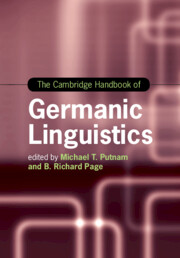Book contents
- The Cambridge Handbook of Germanic Linguistics
- Cambridge Handbooks in Language and Linguistics
- The Cambridge Handbook of Germanic Linguistics
- Copyright page
- Contents
- Figures
- Maps
- Tables
- Contributors
- Acknowledgments
- Germanic Languages
- Part I Phonology
- Chapter 1 Phonological Processes in Germanic Languages
- Chapter 2 Germanic Syllable Structure
- Chapter 3 The Role of Foot Structure in Germanic
- Chapter 4 Word Stress in Germanic
- Chapter 5 Quantity in Germanic Languages
- Chapter 6 Germanic Laryngeal Phonetics and Phonology
- Chapter 7 Tone Accent in North and West Germanic
- Chapter 8 Intonation in Germanic
- Part II Morphology and Agreement Systems
- Part III Syntax
- Part IV Semantics and Pragmatics
- Part V Language Contact and Nonstandard Varieties
- Index
- References
Chapter 1 - Phonological Processes in Germanic Languages
from Part I - Phonology
Published online by Cambridge University Press: 31 March 2020
- The Cambridge Handbook of Germanic Linguistics
- Cambridge Handbooks in Language and Linguistics
- The Cambridge Handbook of Germanic Linguistics
- Copyright page
- Contents
- Figures
- Maps
- Tables
- Contributors
- Acknowledgments
- Germanic Languages
- Part I Phonology
- Chapter 1 Phonological Processes in Germanic Languages
- Chapter 2 Germanic Syllable Structure
- Chapter 3 The Role of Foot Structure in Germanic
- Chapter 4 Word Stress in Germanic
- Chapter 5 Quantity in Germanic Languages
- Chapter 6 Germanic Laryngeal Phonetics and Phonology
- Chapter 7 Tone Accent in North and West Germanic
- Chapter 8 Intonation in Germanic
- Part II Morphology and Agreement Systems
- Part III Syntax
- Part IV Semantics and Pragmatics
- Part V Language Contact and Nonstandard Varieties
- Index
- References
Summary
The present contribution examines phonological processes attested in modern Germanic languages. Focus is placed on segmental changes belonging to one of the following types: assimilation, dissimilation, epenthesis, deletion, coalescence, vowel reduction, strengthening, and weakening. Although some reference is made to diachronic developments, the emphasis in the present article is on those processes that are active in the synchronic grammar.
Keywords
- Type
- Chapter
- Information
- The Cambridge Handbook of Germanic Linguistics , pp. 11 - 32Publisher: Cambridge University PressPrint publication year: 2020
References
References
TPTL: The Linguistics of Dutch, Frisian and Afrikaans Online (Taalportaal.org).
Online Reference
TPTL: The Linguistics of Dutch, Frisian and Afrikaans Online (Taalportaal.org).



